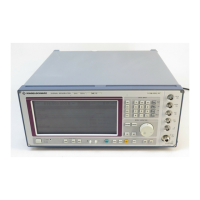SME Structure and Syntax of the Messages
1038.6002.02 3.11 E-13
55 33 0F FF 00 (hexadecimal rep.)
The QuickBASIC-command reads:
CALL IBWRT(generator%, "SOURCE:DM:DATA:DATA #15"+CHR$
(&h55)+CHR$(&h33)+CHR$(&h0F) +CHR$(&hFF)+CHR$(&h00))
– ''#' introduces the binary block.
– ''1' indicates that 1 digit specifying the length will follow next,
– ''5' is the length of the binary block (in bytes).
– 'The actual binary data follow now. As the function IBWRT requires a text
string, CHR$ is used for the type conversion.
The following ASCII format has the same effect:
CALL IBWRT(generator%, "SOURCE:DM:DATA:DATA 0,1,0,1,0,
1,0,1,0,0,1,1,0,0,1,1,0,0,0,0,1,1,1,1,
1,1,1,1,1,1,1,1,0,0,0,0,0,0,0,0")
However, the binary representation is more compact and transmitted faster.
The number of data bits must be an integer multiple of 8 because, according to
IEEE 488.2, binary blocks allow transmission of integer bytes only. Eventually,
the binary block must be filled up to the next byte; the spare bits can then be
deleted manually.
3.5.6 Overview of Syntax Elements
The following survey offers an overview of the syntax elements.
:
;
,
?
*
"
#
The colon separates the key words of a command.
In a command line the separating semicolon marks the uppermost
command level.
The semicolon separates two commands of a command line.
It does not alter the path.
The comma separates several parameters of a command.
The question mark forms a query.
The asterix marks a common command.
Quotation marks introduce a string and terminate it.
ASCI character # introduces block data.
A "white space" (ASCII-Code 0 to 9, 11 to 32 decimal, e.g. blank) separates
header and parameter.

